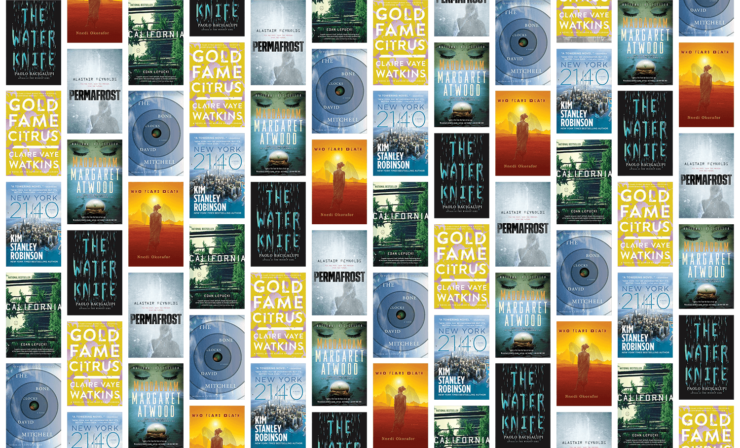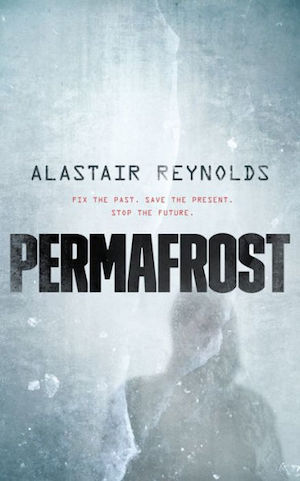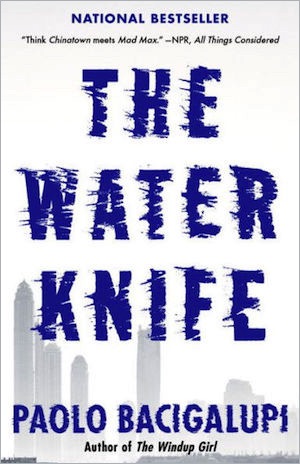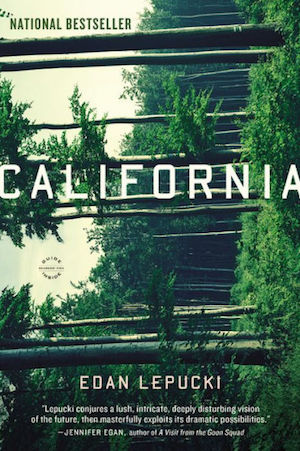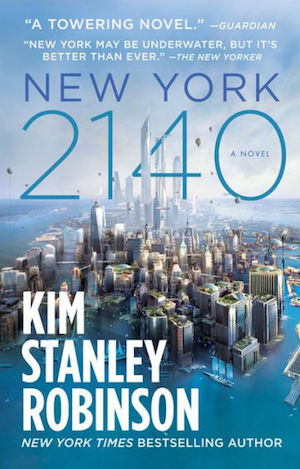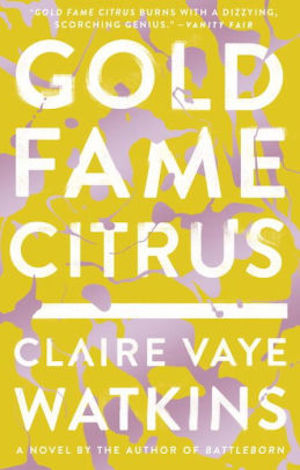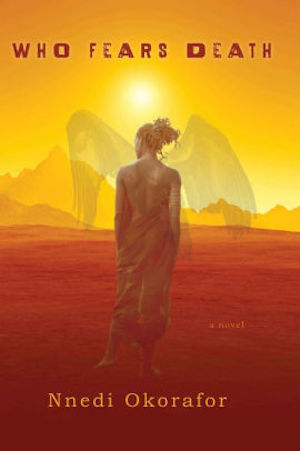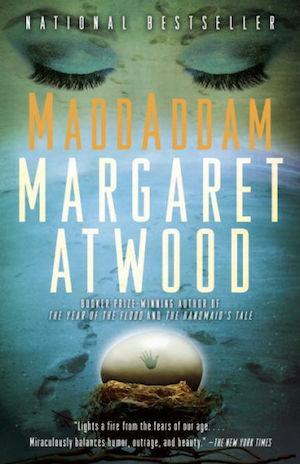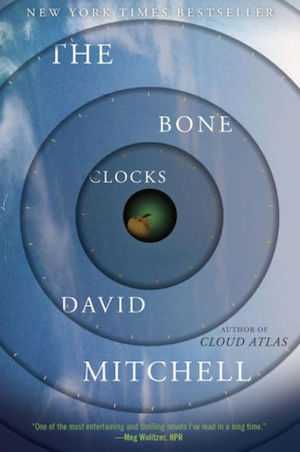So you’ve lived through an ecological disaster that’s drastically changed the world (or at least some corner of it): the water’s dried up, the bees have disappeared, temperatures are soaring, multiple pandemics ravaged the earth, and the oil reserves have gone poof. Now what? Here are eight books that not only take climate change as a given, but that skip ahead a bit and show us the aftermath of environmental cataclysm. A few even offer some possible solutions…
Permafrost by Alastair Reynolds
Permafrost drops us into a bleak world of 2080: most scientists predict about ten more years of before humanity finally runs out of food and people face a decision between slow starvation and euthanasia clinic. But a group of scientists called “The Brothers” have concocted a last ditch effort to save humanity. Using an experimental form of time travel, they will drop an elderly teacher Valentina Lidova into the mind and life of a younger woman in 2028. Once there, Valentina will need to make tiny nudges in the past, hoping all the while that each change is creating a better future.
There’s a problem, though: in 2028, a young woman wakes from brain surgery to find a strange voice in her head. It makes demands of her, and seems to be pushing her onto a new and frightening path. Should she resist the voice? Or follow its lead into an unknown future?
The Water Knife by Paolo Bacigalupi
Paolo Bacigalupi takes us into the future in many of his novels, including The Water Knife, set in an American Southwest that is dying of a never-ending drought. Angel Velasquez is a “water knife”—a saboteur who redirects water supplies to serve his own interests… or, more accurately, the interests of his boss, Catherine Case. Case is working on an “arcological” (architecture + ecology) development in Las Vegas that will be a luxurious self-sustaining environment for those who can afford it. Those who can’t are left in the dust, trying to survive on the supply from the rapidly-drying Colorado River. When a mysterious new water source seems to appear in Phoenix, Angel goes to investigate, crossing paths with a journalist, Lucy Monroe, who risks her life covering the water wars, and a migrant worker, Maria Villarosa, who desperately wants to make it north, where rumor has it rain still falls from the sky. The three soon find themselves caught in a much larger plot, where their lives are under threat from more than just thirst.
California by Edan Lepucki
Los Angeles has become uninhabitable (“Wait, it can get worse?” sniffs the New Yorker writing this piece) and a young couple, Frida Ellis and Calvin Friedman, flee to the North. They squat in an abandoned home and eke out a living as subsistence foragers and farmers, when they realize Frida is pregnant. They have to weigh their options: should they attempt to join a “Community”—havens for wealthier survivors—where they would have access to the internet, reliable food, and a measure of safety? How much freedom would they have to sacrifice, and would it be worth it? And in the end, is the Community truly any safer, or is just dangerous in a different way? Lepucki’s novel drops us into an untenable situation and forces us to weigh the lengths we’ll go to for survival in a post-collapse world.
New York 2140 by Kim Stanley Robinson
Meanwhile, on the East Coast, Kim Stanley Robinson’s New York 2140 posits a future New York City that resembles the Venice of our own time. Most of the major trade and culture of the United States is now centered on Denver, but plenty of die hards have stayed in New York. While some people have taken up residence on the top floors of partially-submerged buildings, the wealthy have fled up to Harlem, Inwood, and Yonkers, which remain largely unaffected, leaving those below 46th Street to deal with the worst of the flooding. The book’s action centers on the tenants of MetLife Tower on 23rd Street (just across the park from Stubby the Rocket’s main dock!) which offers boat storage to its waterlogged residents. Robinson’s book takes an honest look at the connections between capitalism and climate change, but it’s also funny, focusing on how humans adapt to extreme circumstances.
Gold Fame Citrus by Claire Vaye Watkins
Like The Water Knife and California, Claire Vaye Watkins’ novel Gold Fame Citrus focuses on a Southwest coping with extreme drought. In this case, Los Angeles hasn’t seen a drop of rain in years, and the entire region is being swallowed by a growing desert known as the Amargosa Dune Sea. Most people have been evacuated to the East, where life is still a bit more viable, but if you’re the right kind of damaged, like former model Luz, or the right kind of AWOL, like her boyfriend, former soldier Ray, you might not want to be back in civilization where the National Guard watches the borders and everyone is expected to contribute to society. So the two cobble a life together in L.A.—until they find a needy infant and adopt/rescue/kidnap it. Soon the trio are setting out on the Dune Sea, looking for literally greener pastures, and facing dangers they couldn’t even imagine back in Los Angeles.
Who Fears Death by Nnedi Okorafor
Nnedi Okorafor imagines a post-collapse future where magic blooms in a desert. For years, the Okeke people have been enslaved and terrorized by the Nuru. When an Okeke woman is raped, and barely survives the destruction of her village, she decides to walk into the desert and die rather than live under the Nuru’s brutality any longer. But death does not come, and when she gives birth to a baby the color of sand, she decides to try to make a new life with her. She names her daughter Onyesonwu—meaning “Who Fears Death”—and the girl soon proves to be unusual. As a child of rape she is marked by her society as an “Ewu”, expected to live a life of violence. Instead she is stubborn, intelligent, and magical, learning to shapeshift and travel to spiritual realms before she reaches her teens, and finally embarks on a quest that will lead her back into the desert. Her destiny is tied to the violent history of her people, and to the land and its destruction—but will her quest free her or doom her?
Maddaddam by Margaret Atwood
Maddaddam is the final book in a trilogy by Margaret Atwood—after the bioengineered pandemic and chaos depicted in Oryx and Crake and The Year of the Flood, Maddaddam follows Ren and Toby as they work to establish a new community. They join with other survivors (some of whom also showed up earlier in the trilogy) and try to create decent relationships and foster hope among the ruins of civilization. The book hops from the present through a series of flashbacks that show how the upper class knowingly trampled the environment, before returning us to the post-collapse present and asking if it’s even possible to rebuild society in a healthier way.
The Bone Clocks by David Mitchell
The Bone Clocks takes place within the David Mitchell Ever-Expanding Universe. Characters from past books show up in new roles, and if you’ve been reading Mitchell for a while, you’ll notice the foundations of the world itself starts to shake. The Bone Clocks more-or-less follows the life of one Holly Sykes, from the age of 16 on up, checking in every few years from the points of view of friends, lovers, and even enemies. Because we know her and her circle so well, the final section of the book makes for a brutal read: an off-page technological collapse is followed by a failure of the world’s oil supply, and by the time we reunite with Holly, society has been jarred into a much more primitive state. We have to watch a woman we’ve known since her teens cope as her village descends into a landscape out of a Mad Max movie. But, as in Mad Max, where there are still decent people there is hope, and Mitchell doesn’t entirely crush our souls. Just most of the way.
Buy the Book
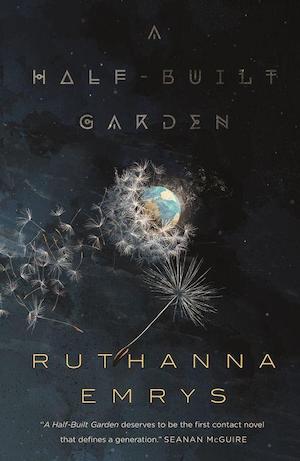

A Half-Built Garden
Originally published February 2019.










